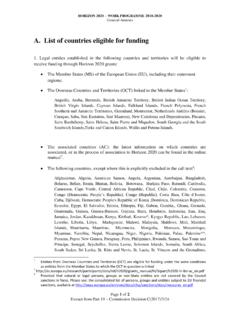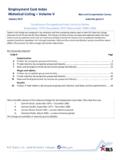Transcription of Bronchoscopy and Associated Procedures Coding in ICD-10 ...
1 1 Bronchoscopy AND Associated PROCEDURE Coding IN ICD-10 -PCS AND CPT WHY AND HOW IS A Bronchoscopy PERFORMED? A Bronchoscopy is a test to view the airways and diagnose lung disease. It may also be used during the treatment of some lung conditions. A bronchoscope is a device used to see the inside of the throat, larynx, trachea, airways and lungs. The scope can be flexible or rigid. A flexible scope is almost always used. It is a tube less than 1/2-inch wide and about 2 feet long. In rare cases, a rigid bronchoscope is used. This is done when there is bleeding in the airway that could block the flexible scope s views or to remove large tissue samples for biopsy. A rigid scope may also be used to clear food or other objects in the airway. Here is how the Bronchoscopy is performed: The scope is passed through the mouth or nose through the windpipe (trachea) and into the lungs. Going through the nose is a good way to look at the upper airways. Going through the mouth allows the doctor to use a larger bronchoscope.
2 If a flexible bronchoscope is used, the patient will probably be awake but sedated. During the procedure: The patient will likely get medicines through a vein (intravenously) to help them relax. Or the patient may be put under general anesthesia, especially if a rigid scope is used. A numbing drug (anesthetic) will be sprayed in the mouth and throat. If Bronchoscopy is done through the nose, numbing jelly will be placed in one nostril. The scope is gently inserted. It will likely make the patient cough at first. The coughing will stop as the numbing drug begins to work. The doctor may send saline solution through the tube. This washes the lungs and allows the doctor to collect samples of lung cells, fluids, and other materials inside the air sacs. This part of the procedure is called a lavage. Sometimes, tiny brushes, needles, or forceps may be passed through the bronchoscope to take very small tissue samples (biopsies) from the bronchial tissue within the bronchus.
3 At times a forceps or other instrument such as a needle may be passed through the bronchial wall into nearby lung tissue proper or lymph nodes. This is usually done under fluoroscopy so the physician can see where to guide the instrument. The coder should really search the operative note for this information as it makes a difference. The physician can also place a stent in the airway or view the lungs with ultrasound during the procedure. Sometimes ultrasound is used to view the lymph nodes and tissues around the airways. The below photos depict how a Bronchoscopy is performed: 2 ANATOMY OF THE BRONCHUS AND LUNGS AND THE RELATION TO Coding The respiratory system is composed of various structures. It is important for the coder to be able to differentiate these different structures as bronchoscopic Procedures can be performed on bronchial tissue, lung tissue, lymph nodes, and other structures. Physicians sometimes use the term lung loosely when they actually are addressing bronchial tissue.
4 They many times use lung and bronchial or bronchus interchangeably. This makes it very confusing for the coder to choose the correct code, especially in ICD-10 -3 PCS because there are body part values for both bronchial tissue and lung tissue by segment. This is a frequent error for coders, Coding to lung tissue when the physician is actually biopsying bronchial tissue. Looking at the pathology report can sometimes be helpful however many pathologists use the terms lung and bronchial tissue interchangeably as well in the headers. Coders must read the entire pathology report to ascertain what tissue was taken. It rests with the coder to accurately identify the specific site of the procedure or to query when it is not easily discernable within the medical record. Photo 1: This first photo is basic, however it does show that there are three lobes on the right and two lobes on the left. When Coding in ICD-10 -PCS there are body part values for both the lung and the bronchus in each of these areas.
5 Photo 2: Next we have a simple diagram of the segments within the bronchi and lungs. 4 Photo 3: The below is an excerpt from ICD-10 -PCS to show the coder the body part values in the respiratory body system. Note that there are separate body part values for both the bronchus and lung by lobe. We have also broken out the different bronchopulmonary segments for each lung following the excerpt. The right lung has 10 bronchopulmonary segments: Superior/Upper lobe: Apical Anterior Posterior Middle lobe: Medial Lateral Inferior/Lower lobe: Superior Anterior basal Posterior basal Medial basal Lateral basal 5 The left lung has 8 to 10 bronchopulmonary segments: Superior/Upper lobe: Apical (may be combined with posterior to form apicoposterior) Posterior Anterior Superior lingular Inferior lingular Inferior/Lower lobe: Superior Anterior basal (may be combined with medial to form anteromedial basal) Medial basal Lateral basal Posterior basal Photo 4: The photo below depicts the branching out of the bronchus out to the alveoli.
6 The bronchioles are considered bronchus and the alveoli are considered lung tissue. Bronchioles are minute branches into which a bronchus divides. The bronchioles connect to the alveoli (air sacs). Alveoli are any of the many tiny air sacs in the lungs at the ends of bronchioles where the exchange of oxygen and carbon dioxide takes place. Hence they are considered part of the lung body part values. They also have capillaries around each alveolus where the air exchange takes place in the blood. When a physician takes lung tissue after puncturing through a bronchial wall, it is frequently alveoli (lung) tissue which is being biopsied. A human adult lung contains an average of 480 million alveoli. 6 Coding CHALLENGES IN ICD-10 -PCS We will first address the nuances of Bronchoscopy Coding in ICD-10 -PCS. Discussion of CPT Coding will follow further below. As mentioned earlier, one of the most frequent errors coders make is Coding a transbronchial biopsy to a code for lung tissue excision when there is no evidence that actual lung tissue was excised.
7 This will change the DRG on the case. Consider the following: A patient has a mass of the left upper lobe lung and is scheduled for bronchoscopic biopsy. The physician states that the patient is scheduled for a lung biopsy. The physician inserts the scope, views the bronchial tree and then takes an endobronchial biopsy of tissue in the left upper lobe bronchus. Viewing the pathology report validates this is bronchial tissue. The bronchus is not punctured and no actual lung tissue is biopsied. Pathology report confirms bronchus malignancy. INCORRECT Coding AND DRG: Diagnosis: , Malignant neoplasm of upper lobe, left bronchus or lung Procedure: 0 BBG8ZX, Excision left upper lung lobe, endoscopic, diagnostic DRG: 168, Other resp system proc. w/o CC/MCC RW CORRECT Coding AND DRG: Diagnosis: , Malignant neoplasm of upper lobe, left bronchus or lung Procedure: 0BB88ZX, Excision left upper lobe bronchus, endoscopic, diagnostic DRG: 182, Respiratory neoplasms w/o CC/MCC RW As the coder can see, assuming the physician s term lung literally, can result in an incorrect procedure code and DRG assignment.
8 This is actually an area of OIG and RAC reviewer focus. Keep in mind that the term transbronchial literally is defined as through, beyond or across the bronchus however it can also be interpreted as through or within the bronchus. This is why it is such a difficult Coding area. The coder MUST read the operative report and pathology report to ascertain what type of tissue was actually biopsied. The original intent of the term transbronchial lung biopsy was to infer an actual biopsy of lung tissue was taken. However, reading many operative reports, coders will see that this is not always the case. Since this impacts the DRG, attention to the actual tissue biopsied in the report is a must. In addition, coders must be cautious when selecting terms in an encoder. Coders can easily be led to incorrect codes depending on the terms selected. Coders must always verify their codes in the tabular of both types of code books. From the AHA ICD 10 Coding handbook: Bronchoalveolar lavage (BAL), also called liquid biopsy, should not be confused with whole lung lavage.
9 BAL is a diagnostic procedure performed via a bronchoscope under local anesthesia. It involves washing out alveoli tissue and peripheral airways to obtain a small sampling of tissue. BAL is coded to the root operation Drainage because it involves removing fluids. The body part value should be chose for the particular LUNG lobe that the BAL is focused on. Recently AHA updated an older Coding Clinic, changing the body part value to LUNG: 7 Correction Notice: Bronchoalveolar Lavage Coding Clinic, First Quarter 2017: Page 51 Summary: Coding Clinic, First Quarter 2016, page 26, contained an error regarding the appropriate ICD-10 -PCS code for bronchoalveolar lavage (BAL). The previous code was assigned to lower lobe bronchus in error. BAL involves washing out and sampling alveoli of the lung (small sacs within the lungs). The appropriate code assignment for a BAL is 0B9J8ZX Drainage of left lower lung lobe, via natural or artificial opening endoscopic, diagnostic since the lung body part values more accurately capture the objective of bronchoalveolar lavage, The BAL of the peripheral airways is included in the code assigned to the body part lung so no extra code needs to be assigned.
10 So bottom line, for BAL assign lung body part not a bronchus body part. Whole lung lavage is a therapeutic procedure performed for pulmonary alveolar proteinosis. The procedure is performed under general anesthesia and mechanical ventilation. The lungs are lavaged by filling and emptying one lung at a time with saline solution. The second lung is usually lavaged three to seven days after the first lung has been lavaged. Report whole lung lavage using code 3E1F88Z, Irrigation of respiratory tract using irrigating substance, via natural or artificial opening endoscopic. Assign also a code for the mechanical ventilation provided. Code 3E1F88Z would not be assigned for washings only. See Coding Clinic, First Quarter 2017: Page 51 that addresses when washings are performed with BAL. Coders will need to report separate codes for each separate lobe biopsied, whether lung tissue or bronchus tissue. For example, if a Bronchoscopy is performed and the physician performs endobronchial biopsy of the right upper lobe bronchus and right lower lobe bronchus, then two codes are reported: 0BB48ZX for the bronchoscopic biopsy of the right upper lobe bronchus 0BB68ZX for the bronchoscopic biopsy of the right lower lobe bronchus If lymph nodes were biopsied via Bronchoscopy and TBNA (transbronchial needle aspiration) then the below code would be added: 07B74ZX for the biopsy of thorax lymph nodes via needle.





